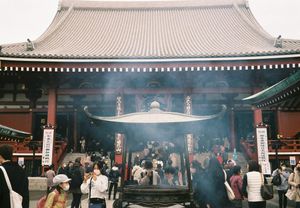What foreign investors are missing out when they buy Japanese stocks – The history and current state of Kabunushi Yutai, shareholder benefits in Japan
What Warren Buffet is missing out on. The bit of history and the current state of Kabunushi Yutai, shareholder benefits in Japan

Imagine Coca-Cola sending you a 12 pack of special limited edition Coke, or Air France offering you a $50 domestic flight...well that's basically what many large Japanese corporations do for their shareholders.
How have these shareholder gifts come to be and how do they affect how individuals invest in the stock market? And what exactly are these benefits that foreign investors like Warren Buffett are missing out on?
In Japanese, shareholder benefits are called Kabunushi Yutai (株主優待) or yutai for short. These benefits do not exist in most countries like they do in Japan (and likely the reason why the word is not translatable.)
Let’s break down the Kanji:
株主 *(kabunushi): *Shareholder
優待 (yutai): Preferential treatment, hospitality; warm reception
As you can see, the direct translation is a little difficult. Essentially, yutai are incentives offered by public companies to individual investors to invest in their company. Some examples of benefits include gift certificates, food, and vouchers. We will explore more examples below.
Why do kabunushi yutai work in Japan? One reason might be because gift giving is a major part of Japanese culture. These shareholder benefits are a way that corporations show gratitude to their shareholders.
Typically there is a minimum number of shares you must own to get the gifts such as 100 or 1,000 shares. Ownership via mutual funds or ETFs does not count. Furthermore, they are only available to domestic investors.
This article explores the history of shareholder benefits, effects of the benefits, types of yutai, and investor Hiroto Kiritani.
Let’s dive in.
Basic History of kabunushi yutai
The beginning [1899~ Post WWII]
These shareholder gifts have been around for some time, dating back to 1899 (or Meiji Period 32). It is said that what is now Tobu Railway Company was the first company known to offer these perks. Shareholders with over 300 shares received an all-lines rail pass, allowing them to ride any of Tobu’s railways.
Even after WWII, these yutai were only offered by certain companies such as movie theatres, department stores, and railway companies. It was common for shareholders to give their perks away as a gratuity to those they interacted with, such as the fishmonger or a shopkeeper. For the company and shareholders this was a win-win situation. The company guaranteed a shareholder and the shareholder felt that they were getting value from their investment.
Kabunushi yutai start taking off [1980-2000s]
Kabunushi yutai started taking off in the 1980s – when the Japanese stock market was booming – gaining ownership from normal retail investors or individuals.
At the time, there were over 100 companies known to offer benefits. The types of perks also expanded. Previously, it was mostly coupons and vouchers, but now, products and gifts were offered. For example, Nissin Foods (owner of Cup Noodle) sent out gift boxes with their food.
After the economic bubble popped in the 90s, investors no longer expected stocks to rise nor dividends to be paid out. Yutai were used to prevent investors from divesting. Security companies also started using them to attract and retain retail investors, sending out pamphlets of shareholder benefits. Around this time, retail investors started to seek out certain perks that best suited their own interest and invested in stocks that met their needs.
The 2000s
In the 2000s, companies that offered yutai to increase their awareness and to retain long term investors steadily increased.

According to a survey conducted by Nomura investor relations, about 35% of public companies in Japan offer kabunushi yutai. Despite their long history, most of the growth has happened post bubble.
The total companies offering yutai grew at rate of 4.5% from 1992-2022. While the growth rate does not seem that high, to give you an idea of how well the Japanese stock market was doing, during the same time period, the Nikkei 225 (Japan's stock market index for the Tokyo Stock Exchange) had total returns of only 1.5%.
For instance, in 2000, the company Kagome, known for its vegetable juice, sought to reach one hundred thousand shareholders. To help achieve this goal, they lowered the minimum stock investment from 1,000 shares to 100 shares (in 2000 the price hovered around ~1,000 yen per share. Meaning they lowered the investment from roughly 1 million yen (~$10,000) to 100,000 yen ($1,000)). Furthermore, they began product tasting events and offered yutai not once, but twice a year focusing on seasonal and new products. Kagome saw their shareholders rise from 6,500 to 100,000 individuals in just 4 years.
However, with the crash of the stock market in 2008, many companies ceased their yutai. Interestingly, in order to relinquish the value of their investments, institutional investors started introducing special benefits to incentivize individuals to invest. They started online blogs and social media campaigns aimed at retail investors. There was even, a focus on housewives, with a campaign called “プチリッチを楽しむ“ literally “enjoy a little luxury” (Kabumado).
In 2015, JPX group company Tokyo Stock Exchange, Inc. implemented the Japanese Corporate Governance Code, which influenced the companies on the stock exchange in many ways. One of the effects influenced the shareholder composition of companies. It abolished "cross-holding" where companies mutually hold shares in each other. (Without going into the specifics, some of the biggest issues with “cross holding” is that it leads to incorrect valuation of a company and impedes efforts to improve corporate governance.) Companies looked for long-term shareholders to replace the loss of the cross-holding corporations, leading to companies to further target retail investors.
Who is Hiroto Kiritani? The Warren Buffett of Japan (sort of)

You can’t really talk about kabunushi yutai, without talking about Hiroto Kiritani (桐谷広人 ). And unless you are a big shogi nerd or into Japanese stocks, you’ve probably never heard of him. He is an interesting fellow. Sometimes he is described as the Warren Buffett of Japan, but there are some pretty big differences.
Hiroto Kiritani (who is now a famous investor) has been able to make a living on dividends and shareholder gifts with his investments. He has been attributed to helping popularize yutai in recent years. He has published several books, has many video interviews over YouTube and TV, and a strong Twitter following (>150k followers) to name a few of his publicity.
Born in 1949, he became a famous Shogi player (Japanese chess.) He started trading stocks in 1984, butfamously lost a hundred of millions trading during Japan’s bubble. After retiring from Shogi in 2007, he began to focus on his investing “style” that he is famous for now: seeking out stocks with dividends and yutai programs with a total combined yield of at least 4%, keeping a diverse portfolio, buying low and holding.
He is also well-known for riding his bike (ママチャリ) all over Tokyo and living frugally in an over cluttered apartment. He has estimated over 400 million yen (~$4 million assuming 100 yen to $1.) It’s pretty easy to understand how a large diverse portfolio like Kiritani’s can yield enough benefits to survive the year without spending much of your own money.
Have these shareholder benefits worked?
In a survey conducted by Nomura Investor relations, it asked companies who offer yutai, “what is their purpose / goal of offering yutai?” Most companies answered, “to increase retail investors,” followed by “promoting long-term shareholders.” You can see a stark increase in this answer after 2015 when the Tokyo stock exchange implemented the rules on cross-holding shares.
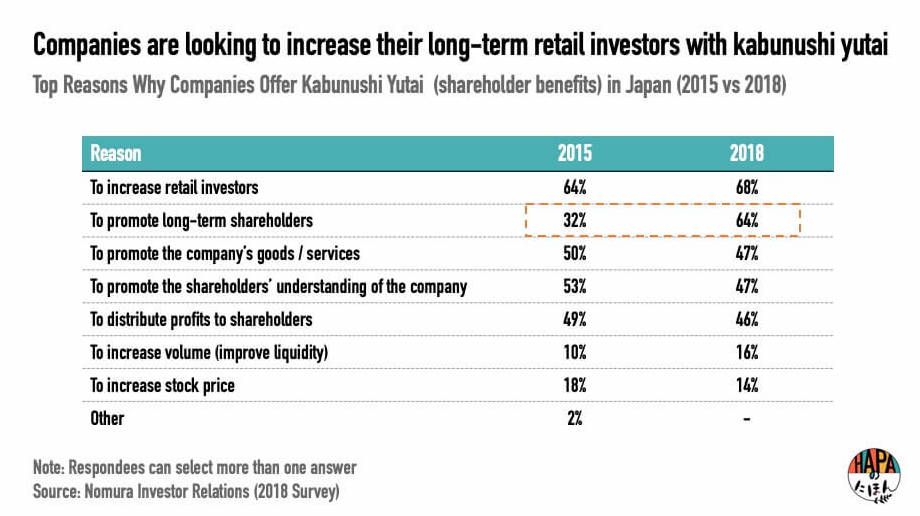
Following this question, Nomura then asked companies whether the yutai were effective for the following outcomes. While the benefits do seem to work in getting individual investors, they do not seem to hold onto these investments for long. Perhaps, this is an outcome that needs more time. After all, three years is not long-term investing.
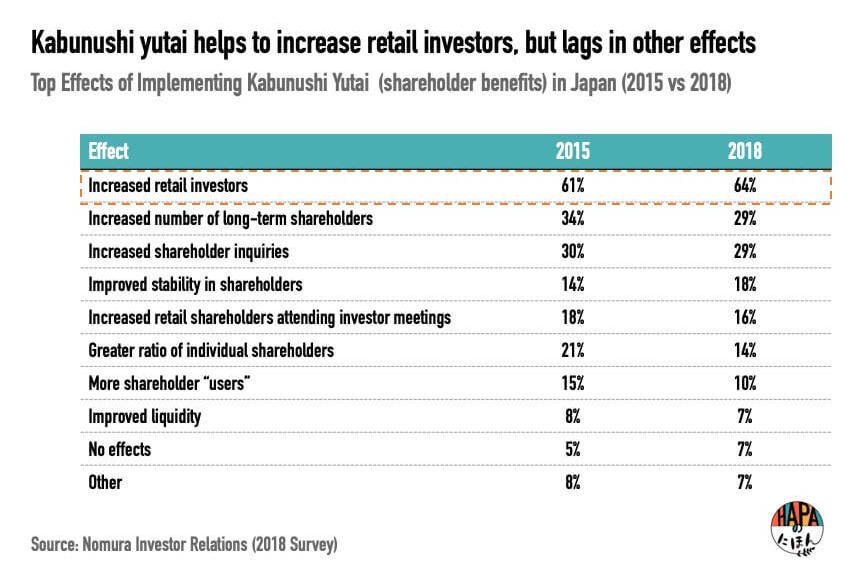
There is other research from Hirota Seminar (2018). From 2001 to 2016, Hirota Seminar conducted a multiple regression analysis for companies on the Japanese stock exchanges. They analyzed the impact of kabunushi yutai on shareholder composition. They found that companies who offered gift certificates and gifts benefits had a higher percentage of individual stockholders, while those who offered company discounts had no significant difference compared to companies that offered nothing. This finding seems to make sense, a gift certificate allows you to save money without having to spend your money, while a discount requires you to spend your own money to receive the savings.
Depending on the goals of the company, there do seem to be some reasons to offer kabunushi yutai.
While companies say that it has increased the number of retail investors, what about from the individual investor review? It depends on the data. According to a survey conducted by SBI, a Japanese brokerage firm, over 90% of retail investors said they were interested in buying stocks with kabunushi yutai in the future. However, looking at investments by age group, older generations are far more likely to invest in Japanese stocks than younger generations. Oddly, people in their 20s own more Japanese than American stocks…maybe the yutai are appealing to them?
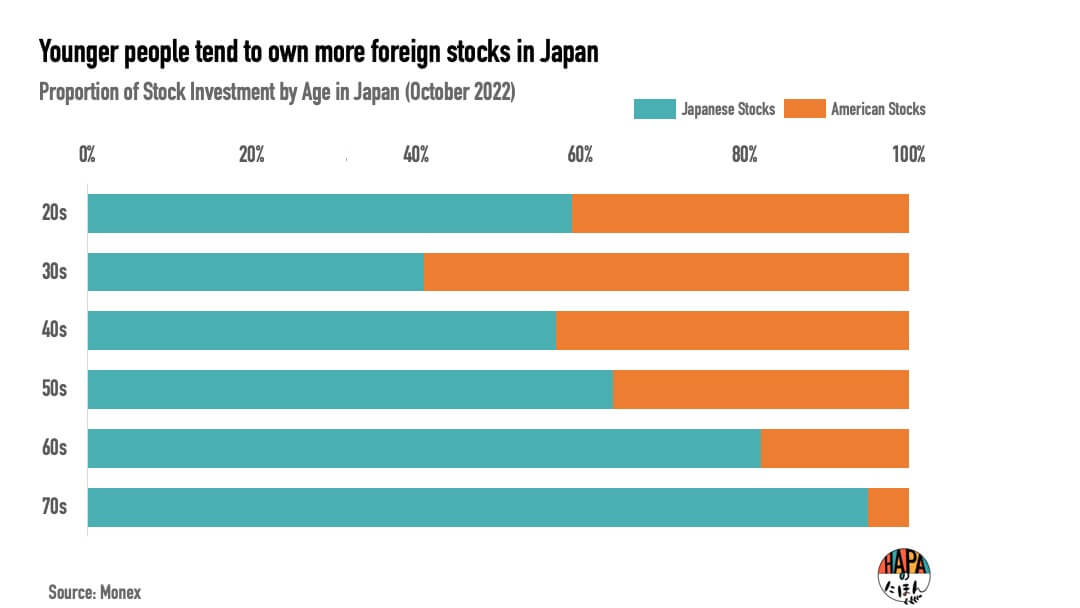
Types of kabunushi yutai
So, what type of kabunushi yutai are there?
A majority of companies give out food or drink gifts (more examples below) and gift certificates / discount coupons. Gift certificates are considered to be offered in lieu of dividends (which makes me wonder why companies don’t just pay out a higher dividend instead. But hey, that is not as fun).
Other types of yutai are free hotel stays, sporting events, food vouchers, and other household items.
Sometimes companies offer better benefits for shareholders who hold for longer periods of time. For instance, Zenkoku Hosho offers a prepaid card of 3,000 yen for those who own at least 100 shares. This increases to 5,000 yen for individuals who own stock for over a year.
Here are some other popular kabunushi yutai:
Aeon
Aeon is a holding company with businesses primarily in retail stores. It is known for its supermarkets and shopping malls. The company offers 3% a cashback card for its stores with ownership of 100 shares, with up to 7% cashback with ownership of 3,000 shares.
McDonalds (Japan Holdings)
I probably don’t need to explain McDonalds to you. With 100 shares, shareholders get 1 coupon book with 6 vouches for a free item (sandwich, side menu, or drink).
Ajinomoto
No matter where you are in the world, if you ever bought Japanese food, it is very likely you have bought or seen Ajinomoto products. Some of their top projects are Hondashi (dashi powder), frozen gyoza, and the famous Aji no moto (basically MSG). With 100 shares, you can get a gift box with 1,500 yen worth of their products, and with 1,000 shares, up to 4,000 yen in value with their products.
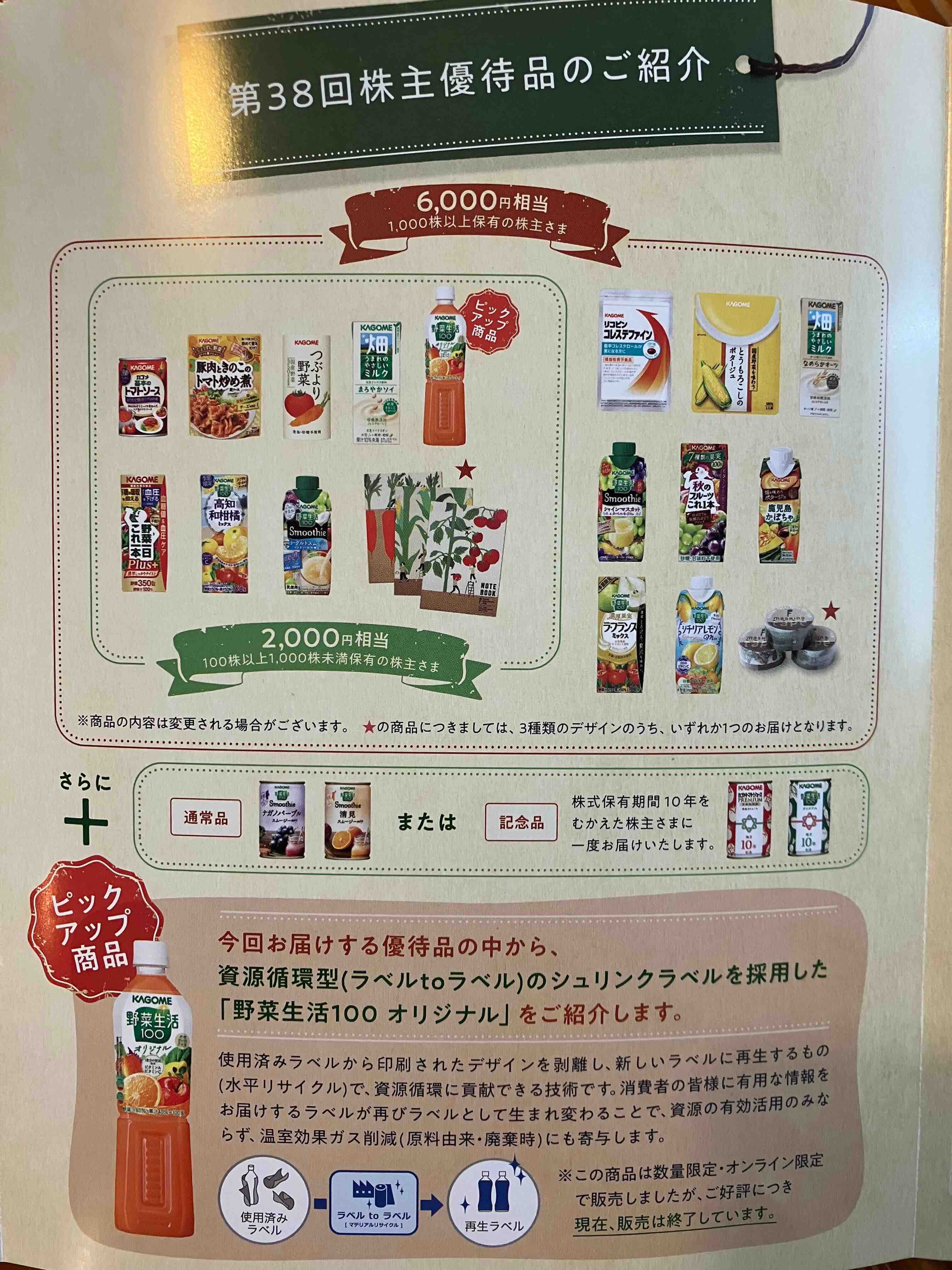
Kagome Kabunushi yutai pamphlet
Final Thoughts
There are a plethora of videos, websites, and articles all about kabunushi yutai (in Japanese), giving people the opportunity to dive in deep. It will be interesting to see how kabunsuhi yutai influence the Japanese stock market in the long-term given their short history.
Just for fun, I looked up the top 5 companies Buffett invested in. Apparently, Buffett invested in Japan's top 5 biggest trading firms – Itochu, Mitsubishi, Sumitomo, Mitsui, and Marubeni – all of which do not offer kabunushi yutai. So, while it seems like Buffett would not have received many gifts from his investments, if he had bought the trading companies’ subsidiaries he would have received quite a few gifts and probably need to buy another room to put all of the gifts or invite a large party of people to help him get through the food (which doesn’t seem like an issue for him.)
All readers, please make good investment decisions.

